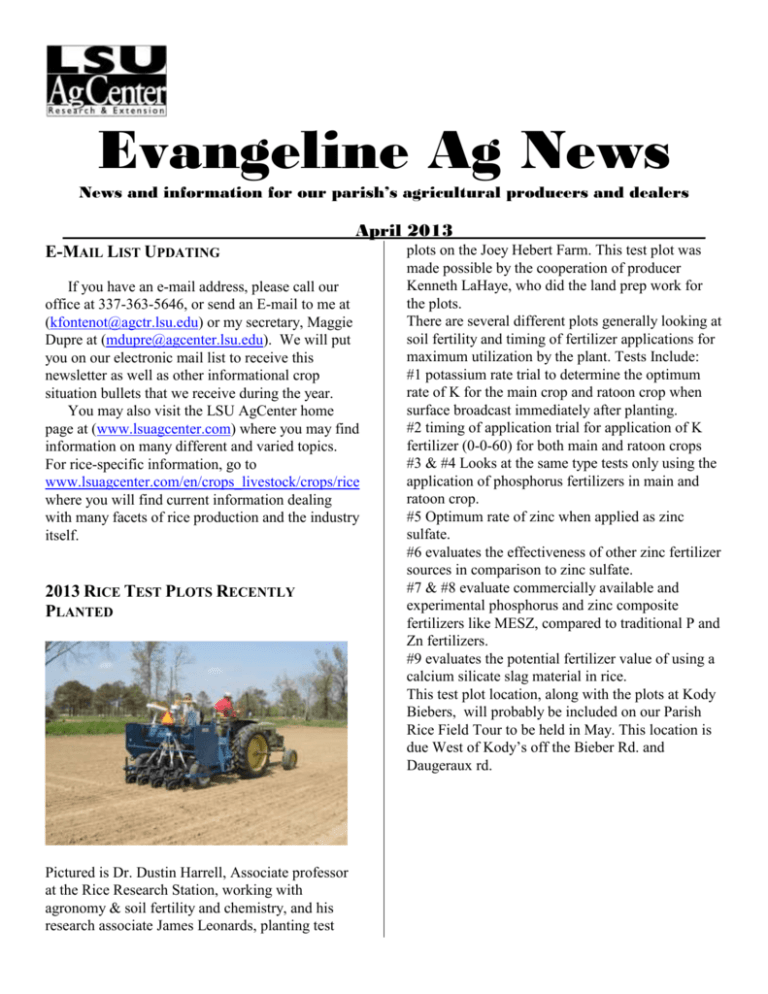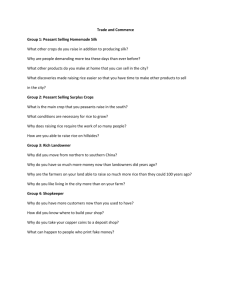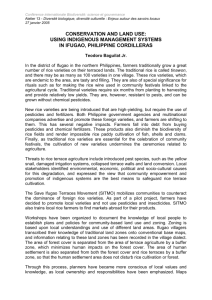CROP SUMMARY - The LSU AgCenter
advertisement

Evangeline Ag News News and information for our parish’s agricultural producers and dealers ________ April 2013 E-MAIL LIST UPDATING If you have an e-mail address, please call our office at 337-363-5646, or send an E-mail to me at (kfontenot@agctr.lsu.edu) or my secretary, Maggie Dupre at (mdupre@agcenter.lsu.edu). We will put you on our electronic mail list to receive this newsletter as well as other informational crop situation bullets that we receive during the year. You may also visit the LSU AgCenter home page at (www.lsuagcenter.com) where you may find information on many different and varied topics. For rice-specific information, go to www.lsuagcenter.com/en/crops_livestock/crops/rice where you will find current information dealing with many facets of rice production and the industry itself. 2013 RICE TEST PLOTS RECENTLY PLANTED Pictured is Dr. Dustin Harrell, Associate professor at the Rice Research Station, working with agronomy & soil fertility and chemistry, and his research associate James Leonards, planting test ___ _ plots on the Joey Hebert Farm. This test plot was made possible by the cooperation of producer Kenneth LaHaye, who did the land prep work for the plots. There are several different plots generally looking at soil fertility and timing of fertilizer applications for maximum utilization by the plant. Tests Include: #1 potassium rate trial to determine the optimum rate of K for the main crop and ratoon crop when surface broadcast immediately after planting. #2 timing of application trial for application of K fertilizer (0-0-60) for both main and ratoon crops #3 & #4 Looks at the same type tests only using the application of phosphorus fertilizers in main and ratoon crop. #5 Optimum rate of zinc when applied as zinc sulfate. #6 evaluates the effectiveness of other zinc fertilizer sources in comparison to zinc sulfate. #7 & #8 evaluate commercially available and experimental phosphorus and zinc composite fertilizers like MESZ, compared to traditional P and Zn fertilizers. #9 evaluates the potential fertilizer value of using a calcium silicate slag material in rice. This test plot location, along with the plots at Kody Biebers, will probably be included on our Parish Rice Field Tour to be held in May. This location is due West of Kody’s off the Bieber Rd. and Daugeraux rd. Pictured is James Leonards, Dr. Harrells’ research associate, planting test plots at the Fontenot Farm in cooperation with Richard and Neal Fontenot. This location is right off the Platin rd. Tests at this location will look at Variety performance at different Nitrogen application rates based on N-Star validation and calibration trials. The second test will evaluate commercial available and experimental phosphorus and Zinc composite fertilizers like MESZ compared to traditional P and Zn fertilizers. Pictured is Dr. Linscombe planting the off station Rice Variety plots at Bieber Farms in Evangeline Parish, just off Bieber Road near Kody’s Bins. This Site at Kody’s has Dr. Linscombes commercial/advanced yield trial which includes 60 experimental lines, as well as a preliminary yield test with 57 Clearfield experimental lines. Included in these plots is a Rice Water Weevil susceptibility study focusing on Clearfield and Non-Clearfield lines for Dr. Mike Stout, Entomologist with the LSU AgCenter. Additional plots also contain studies for Dr. Herry Utomo, associate professor, at the Rice Research Station dealing with Rice Breeding and Genetics, which include measuring Blast Resistance potential of the test lines. Also included are plots for Dr. Ida Wenefreda, assistant professor, working with rice grain quality enhancement at the Rice Research Station, which will look at measured Protein levels in several of the test lines. 2013 LRRVP (La. Rice Research Verification Field) This year the Evangeline verification field is located in the Duralde area. Our farmer/cooperator is Mr. Jeremy Craton. The field was drill planted to Cl111 on Wednesday March 20, at the rate of 54 #’s to the acre. Command was incorporated on the field for pre-emerge weed control. On the second field visit on April 3, the rain gauge registered 5.13 inches. The two pictures above show the emerged seedlings, as well as the development of the seedling root and shoot. With the rain we had this 2 field as several others had some of the lower cuts holding water, due to backed up ditches and canals as can be seen in the picture below. Tale of Two Years Don Groth LSU AgCenter Rice Research Station 2006 and 2012 were very similar disease years in southwest Louisiana rice. Both years were preceded by warm winters that allowed rice, planted the previous year, to overwinter and several rice diseases to survive and multiply on these plants. These lesions produce spores earlier and in higher amounts than normal. This inoculum allowed disease to start attacking the rice crop earlier and to build up to higher levels than ever seen before. In 2006, infection by the fungus Cercospora janseana caused extensive damage to rice sheaths, leaves and heads causing premature ripening, lower yields and poor milling. The disease was so severe and caused so much tissue death that many fields looked like they had a harvest aid applied to them. Disease severity was worsened because two of the most popular rice varieties that year, CL131 and Cheniere, were both susceptible, allowing inoculum to pass from field to field and multiply quickly. 2006 also had long periods of warm, moist weather, which produced a favorable disease environment. Adding to the problem was that the fungicide Quadris, the most common fungicide applied that year, is not effective against this fungus, and an epidemic was inevitable. In 2007, several disease management practices were adopted by rice growers that greatly reduced Cercospora disease development. The growers reduced CL131 and Cheniere acreage and made extensive use of propiconazole-containing fungicides, which are effective at inhibiting Cercospora infections. The fungicide was applied at early boot growth stage to prevent infection, which is the correct timing. Cercospora has remained a minor disease since 2008 in south Louisiana, except in the second crop where fungicides cannot be used, even though CL131, Cheniere and other Cercospora susceptible varieties continue to be grown. In 2012, infection by the overwintering fungus Pyricularia oryzae caused earlier blast development and more extensive damage on the rice crop than normal in south Louisiana. This, in turn, caused significant yield and milling reductions. 2013 CORN VARIETY TEST PLOTS PLANTED Pictured is Mr. Mike Dischler planting the 2013 corn variety test plots on his farm near Centerville. Mr. Dischler uses a 6 row planter on 38 inch spacings for planting both corn and soybeans. There are 17 different varieties in the corn test for this year. These are all stacked varieties. These test plots were planted on March 27th. Later this month we will plant the Soybean variety tests as well. We will keep you informed as to their progress and also have harvest yield data as well. 3 Again, disease development was worsened because the most popular rice varieties, including CL151 and CL261, were very susceptible to blast. The weather was again warm and moist providing a favorable environment for disease development, and blast-effective fungicides were either not used or not applied at the most effective growth stage, which is 50 percent to 70 percent heading. In 2013, it is anticipated that rice producers will shift from susceptible varieties, select the correct fungicide and apply it at the best timing. They also need to use cultural management practices that reduce blast severity. These practices include early planting, maintaining adequate flood levels, and avoiding excessive nitrogen fertility levels, which should limit blast in 2013. An aggressive approach is encouraged in managing blast, including using a diversity of resistant varieties, effective scouting through the season, and the timely initiation of cultural and disease management practices. Cold weather and rice diseases The cold temperatures we are currently experiencing will increase the incidence and severity of several rice seed and seedling diseases. In water-seeded systems, water molds (Figures 1 and 2) can become severe, killing seedlings and significantly reducing stands. In drill-seeded systems water molds can occur, but seeding blights (Figure 3) are more common. Both diseases are caused by infection by pathogenic fungi that attack either the seed’s starch or the seedling tissues. The cool periods slow down seedling growth allowing these fungi to damage the developing seedling or consume the stored food supply in the seed causing poor vigor or death. During warm weather conducive to rice growth, actively growing seedlings can outgrow these diseases. Seed protectant fungicides can reduce seed and seedling diseases but not completely eliminate them. Figure 1. Water mold on rice seeds. Figure 2. Water mold on rice seeds and seedlings Figure 3. Rice seedling blights. 4 SOYBEAN PLANTING AND MATURITY DATES Soybean varieties in Maturity Groups IV-V are recommended for Louisiana because they consistently outperform other maturity groups in quality and yield per acre. The early indeterminate varieties have been grown successfully in certain parts of Louisiana, but poor seed quality and excess shattering can be a problem with them if weather conditions before harvest are warm and wet. Maturity There is a certain amount of overlap in maturity between groups within the state. Environmental conditions, especially drought, can cause variation in maturity. In the southern region of Louisiana, varieties may mature five to 10 days later than in the northern region. Most varieties within a group mature in the following range when planted at recommended times: • Very early maturity — Aug. 10-Aug. 19 • Early maturity — Aug. 20-Sept. 10 • Early medium maturity — Sept. 11-Oct. 1 Dates of Seeding Because weather conditions are different from year to year, seeding dates can be affected by environmental conditions. Early or late planting can cause reduction in plant height in many varieties. Generally, late plantings have less chance of success unless irrigation is available or optimal weather and timely rains occur throughout the growing season. A general rule is that a half bushel per day is lost for every day planting is delayed past the first week of June. Optimal seeding dates for each maturity group planted in Louisiana are: 5 EVANGELINE PARISH CATTLEMAN’S ASSOCIATION ACTIVITIES Blood Drives Also a Beef Month activity, Blood drives will be conducted across the state by many of the parish cattleman’s associations. In Evangeline Parish we currently have two blood drives scheduled as follows: Ranch Tour At the last Associaiton Board meeting held in March , the group discussed the possibility of a Tour for all parish members of , The Branch Ranch. This is a Purebred Brangus operation located near Mansfield, La. Owned by Mr. Tommie Rogers and his family. This ranch has been a seedstock source for many Brangus Bulls used on commercial and purebred herds in and around our area, as well as across the country. Due to the distance this would be an all-day event, tentatively set for Saturday , June 15. The tour will include viewing of all the cattle, including all the coming 2 yr. old bulls that will be offered for sale in the Fall, as well as other cattle and the pasture and hay operation. A lunch will be served as well. To assist in planning and preparing for travel and food, we will mail a letter asking members if they wish to participate or not and sending a reply to the extension office for a head count. We will try to group travel to save on expenses. Saturday, June 8, Jude Landreneau’s Grocery in Pine Prairie Thursday, June 13, Wal Mart parking lot in Ville Platte, 10am-3pm Please encourage family and friends if possible to donate on these days. Donors will receive a T-Shirt, Hamburger, chips and cold drink that association members will be cooking and serving on the spot when donors exit the bus. We encourage everyone to come out and donate blood and get a nutritious, blood building all beef hamburger, and other goodies. If you have any questions, contact me at 363-5646, 230 Court Street in Ville Platte. June is Beef Month During the month of June several Beef Month activities are planned including a signing of the beef month proclamation by the Police Jury President, and the mayors of several local townships and Ville Platte. Also in June look for the “Beef Banners” to be displayed by several local businesses who purchased these to promote the beef month activity. Keith A. Fontenot County Agent Evangeline Parish 6 April 2013 Evangeline Ag News News and information for our parish’s agricultural producers and dealers Visit our LSU AgCenter Store www.lsuagcenter.com/OnlineStore 7







